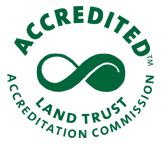"Through a Country Not Well Settled:"
The "Albany Road" of 1752‐1773
In 1999, the RLT (then the RTLC) conducted a special hike over a portion of the "Albany Road," a heretofore unknown Colonial highway dating to 1753 that connected Albany with Deerfield, Massachusetts. Portions of the early road were familiar to historians, but it was not known that they comprised sections of a single highway of considerable significance. Research undertaken over a two‐year period has uncovered a wealth of documentation on the early road. Both published histories and original source documents were studied in this exhaustive search. The entire course of the "Albany Road," including all of its differing courses, was analyzed and mapped in the RLT geographic information system (GIS). A first‐ever history of the road brings the rich history of this region in the mid‐ to late‐18th century to life, explaining the context in which the road was built. This publication allows you to follow the entire road today, often on foot or by auto, from Rensselaer to Deerfield.
The Early Schools Portfolio
Early Schools: Rural and Urban
Surprisingly little information is available on the history of public schools in Rensselaer County, or in New York State as a whole. In 1999, the RLT held its first‐ever program on early schools in the county. Participants visited historic public and private school buildings in rural and urban settings and learned about the differences between rural and urban schools. They heard experts explain not only about early school history, but how students, teachers and citizens can research the history of their own school and identify historic school buildings in their neighborhood. This publication reveals how intriguing our educational history is, and it demonstrates how early school buildings remain a viable part of the county's landscape.
Granville Hicks and Rural Rensselaer County
Granville Hicks (1901‐1982) was one of America’s most important twentieth‐century literary critics, and also a socialist, novelist, and well‐known proponent of the small town. He moved to Grafton in 1932 and purchased the old Francis West house on Shaver Pond Road. Much of the Hicks property is now part of Grafton Lakes State Park. While a Grafton resident, he authored a number of works, in particular Small Town in 1946. Hicks was active in founding the Grafton Library, Grafton Fire Company and Grafton Fire District , and in school and town activities, as well as wartime efforts. He became widely recognized as a proponent of rural America and the small town, through his writings and his participation in a famous 1946 public radio debate and subsequent Life Magazine article.
The Streeter Centennial Hike Portfolio
The Streeter Centennial Hike
"Wanderings in Rensselaer," was published in the Chatham Courier in 1895. In his wanderings, Samuel S. Streeter reminisces about early settlers who lived and worked on the "West Mountain." Relying on both oral history and research into archival records, R‐TLC Director, Doree Cox, traced Samuel Streeter's journey into the past, and in the process uncovered a wealth of information on this part of Berlin. In 1995, we hiked along Samuel Streeter's route, and witnessed the history of land abandoned by farmers and taken over by the forest years ago, come back to life.
A Landscape Transformed: Lock 4 Canal Park documents the construction of Champlain Barge Canal Lock 4, and the alteration of the junction of the Hoosic and Hudson Rivers.
Lock 4 Canal Park, owned by the New York State Canal Corporation, is located in the Town of Schaghticoke, Rensselaer County, at Lock 4 of the Champlain division, where the Hoosic River enters the Hudson opposite Stillwater. Before the construction of the Lock in 1908‐1912, three shale bluff islands existed at this confluence. The canal construction significantly altered the landscape, transforming two of these islands into part of the mainland. While the area is still highly scenic, the configuration and use of the land has changed markedly. Barge Canal records held by the New York State Archives are used to document these land changes and the canal construction process.
By the 1890s the canal system, dating from the opening of the famous Erie Canal in 1825, had become outdated and then Governor Theodore Roosevelt authorized a study, issued in 1900, which recommenced the construction of an entirely new modern canal system. This culminated in the construction and operation of the New York State Barge Canal System, which was completed in 1918. The Champlain Division of the Barge Canal begins in the Hudson River between Lansingburgh and Waterford and runs to Lake Champlain. It follows the entire western boundary of the Town of Schaghticoke. Champlain Division Locks 1, 2, 3 and 4 are located in this section of the Hudson.
The construction of Lock 4, opposite the Village of Stillwater, required major construction at the mouth of the Hoosic River, including two new dams, a major bridge and canal cut. Two islands became part of the mainland and old channels were filled in or became wetlands. The State acquired 91 acres of land, part of which later became Lock 4 Canal Park.
The park includes a picnic area, observation platform at the lock, a canoe launch, and short nature trails. The area is highly scenic, where shale bluffs overlook the Hoosic River raging over a series of rapids immediately before entering the Hudson. The park has been identified as a significant plant habitat, containing a wide diversity of species, including some state‐listed rare plants.



